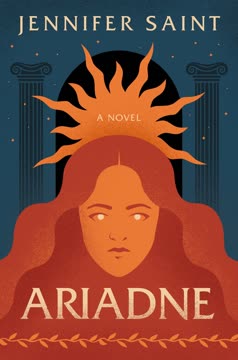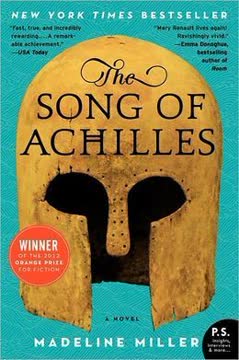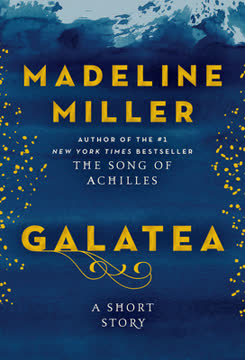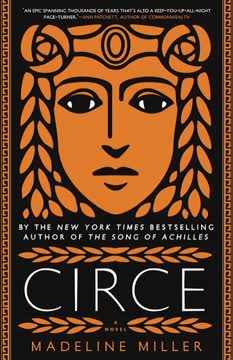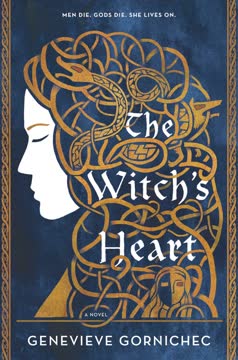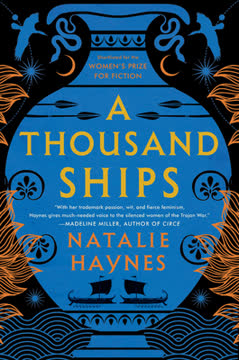Plot Summary
Cretan Shadows and Sisterhood
Ariadne and Phaedra, daughters of King Minos and Queen Pasiphae, grow up in the shadow of their family's shame: the monstrous Minotaur, their half-brother, imprisoned beneath the palace. Their childhood is marked by stories of gods' cruelty, women's suffering, and the ever-present threat of the labyrinth. Ariadne, sensitive and imaginative, finds solace in dance and her bond with her sister, while Phaedra's spirit is shaped by the palace's coldness and the world's injustice. The sisters' relationship is a fragile haven amid the cruelty of Minos and the indifference of the gods, setting the stage for their intertwined destinies.
Birth of the Minotaur
The Minotaur's arrival is a curse born of divine vengeance: Pasiphae, bewitched by Poseidon, gives birth to a half-bull, half-human child. Ariadne witnesses her mother's descent into grief and madness, and the palace's transformation into a place of fear and revulsion. The Minotaur, once a helpless infant, becomes a symbol of Crete's power and shame, locked away in Daedalus' labyrinth. Ariadne's compassion for her brother is mingled with horror, and she learns that women bear the consequences of men's hubris. The sisters' innocence is lost, and the labyrinth's shadow falls over their lives.
Daughters in the Labyrinth
As the years pass, Ariadne and Phaedra are increasingly isolated by their family's notoriety. Minos uses the Minotaur as a tool of power, demanding Athenian tributes to feed the beast. Ariadne, haunted by guilt and pity, dances to escape the palace's suffocating atmosphere. Phaedra dreams of escape and a life beyond Crete. Both sisters are shaped by the knowledge that their fates are not their own, and that the gods' attention brings only suffering. The labyrinth becomes a symbol of their entrapment, and the sisters cling to each other as their only source of comfort.
The Arrival of Theseus
When Theseus, prince of Athens, arrives as a tribute, Ariadne is captivated by his courage and beauty. The funeral games held in his honor reveal his strength and charisma, and he quickly becomes the center of attention. Ariadne and Phaedra are drawn to him for different reasons: Ariadne sees a chance for love and escape, while Phaedra is entranced by his legend. Theseus' presence disrupts the palace's routines and awakens new possibilities for the sisters, but also sets in motion a chain of events that will test their loyalty and courage.
Games, Sacrifice, and Defiance
As the day of sacrifice approaches, Ariadne is torn between her duty to her family and her growing love for Theseus. She seeks help from Daedalus, who gives her the secret of the labyrinth: a red thread to guide Theseus out. Ariadne's decision to betray her father and save Theseus is an act of defiance against the gods and the world's injustice. The sisters' bond is tested as Phaedra is drawn into the plot. The night before the sacrifice, Ariadne and Theseus share a moment of intimacy and resolve to change their fates, setting the stage for betrayal and escape.
The Red Thread Bargain
Armed with Daedalus' thread and her own resolve, Ariadne helps Theseus navigate the labyrinth and slay the Minotaur. The act is both a liberation and a crime: Ariadne sacrifices her brother to save her lover, and in doing so, severs her ties to Crete forever. The escape is fraught with danger and heartbreak, as Phaedra is left behind and Ariadne must confront the consequences of her choices. The red thread becomes a symbol of agency and loss, binding Ariadne's fate to Theseus and to exile.
Night of Betrayal
Fleeing Crete with Theseus and the freed Athenian youths, Ariadne dreams of a new life. But on the island of Naxos, Theseus abandons her while she sleeps, leaving her alone and heartbroken. The betrayal is devastating: Ariadne's sacrifice is repaid with desertion, and she is left to face the gods' indifference and her own despair. The island becomes both a prison and a place of transformation, as Ariadne confronts the reality of her powerlessness and the cost of love.
Escape and Abandonment
Alone on Naxos, Ariadne is consumed by grief and rage. She mourns her lost sister, her shattered dreams, and the cruelty of the gods and men. The island's barrenness mirrors her isolation, and she contemplates death. Yet, in her darkest moment, a miracle occurs: Dionysus, god of wine and ecstasy, arrives, bringing abundance and the promise of a new beginning. Ariadne's encounter with Dionysus marks a turning point, as she is offered a chance at redemption, love, and agency beyond the reach of mortal men.
Naxos: Island of Exile
Dionysus courts Ariadne with kindness and understanding, offering her a place as his consort and priestess. The island flourishes under his influence, and Ariadne discovers a community of women—maenads—who have also fled suffering and oppression. Through Dionysus, Ariadne learns the power of joy, creativity, and self-determination. She becomes a mother, a leader, and a symbol of resilience. Yet, the shadow of her past and the complexities of immortality linger, as she navigates the challenges of love, loss, and the demands of a god.
Dionysus' Arrival
Dionysus' love transforms Ariadne's life, but it comes with its own challenges. As the god's cult grows, so does his need for worship and adoration. Ariadne witnesses the ecstatic, sometimes violent rites of the maenads, and grapples with the tension between mortal and divine love. The birth of her children brings joy and anxiety, as she fears the gods' capriciousness and the fragility of happiness. Dionysus' restlessness and ambition strain their relationship, and Ariadne must confront the limits of her power and the cost of loving a god.
A God's Courtship
The marriage of Ariadne and Dionysus is both a sanctuary and a crucible. Their love is passionate and creative, but haunted by the knowledge of mortality and the inevitability of loss. Ariadne becomes the guardian of Naxos, a haven for women, but is troubled by the darker aspects of Dionysus' cult and the sacrifices it demands. The couple's happiness is threatened by Dionysus' longing for recognition and the encroachment of the outside world. Ariadne's crown is set among the stars, a symbol of her enduring legacy and the bittersweet nature of her fate.
Phaedra's Fate in Athens
Phaedra, married to Theseus as part of a political alliance, finds herself trapped in a loveless and isolating union. She struggles with motherhood, longing for connection and meaning. The arrival of Hippolytus, Theseus' son by the Amazon queen, awakens forbidden desires and a sense of possibility. Phaedra's longing for love and agency mirrors Ariadne's earlier struggles, and her choices set in motion a new cycle of tragedy and loss. The sisters' fates remain intertwined, even across the sea.
Maenads and Motherhood
On Naxos, Ariadne builds a community of women who have fled violence, oppression, and heartbreak. The maenads' ecstatic rites are both a source of liberation and a reminder of the world's cruelty. Ariadne's role as mother and leader is complicated by the demands of Dionysus' cult and the ever-present threat of divine retribution. The stories of the women—Euphrosyne, the grieving mother; the maenads, seeking solace—echo Ariadne's own journey. The island becomes a microcosm of women's resilience and the search for meaning in a world shaped by men and gods.
The Price of Immortality
Ariadne and Dionysus' relationship is tested by the realities of mortality and divinity. Dionysus' ability to restore life is limited to animals, and the pain of loss is ever-present. Ariadne grapples with the knowledge that her children and friends will die, while Dionysus will endure. The god's ambition and need for worship lead to conflict and tragedy, as he seeks to assert his power in the world. Ariadne's longing for peace and stability is at odds with the demands of immortality, and she must choose between love and self-preservation.
Phaedra's Forbidden Love
Phaedra's passion for Hippolytus grows into obsession, fueled by loneliness and the emptiness of her marriage. Her confession of love is met with horror and rejection, shattering her hopes and sense of self. In despair, Phaedra accuses Hippolytus of violating her, setting off a chain of events that will destroy them both. The tragedy is rooted in the same patterns of suffering and injustice that have haunted the sisters' lives, and Phaedra's fate becomes a cautionary tale of desire, agency, and the consequences of defying the world's rules.
Tragedy in Athens
Phaedra's accusation leads Theseus to curse Hippolytus, invoking Poseidon's wrath. Hippolytus is killed in a violent accident, and Phaedra, consumed by guilt and shame, takes her own life. Ariadne, arriving too late to prevent the tragedy, is left to mourn her sister and reflect on the cycles of suffering that bind women's lives. The aftermath is marked by grief, regret, and the recognition that the world's injustices are perpetuated by both men and gods. The sisters' stories converge in loss, but also in the hope of transformation.
The Rites of Dionysus
Ariadne witnesses the true nature of Dionysus' rites: the maenads' frenzied sacrifices, the god's power to restore life to animals but not to humans. The rituals are both a source of catharsis and a reminder of the limits of divine mercy. Ariadne is forced to confront the darkness within her husband and the cult she has helped build. The island's peace is shattered, and Ariadne must decide whether to remain complicit or to seek a new path for herself and the women of Naxos.
The Argive Reckoning
Dionysus' desire for recognition leads him to challenge his brother Perseus in Argos. When the city's women refuse to join his cult, Dionysus unleashes a madness that results in the deaths of their children. The horror of the event exposes the dangers of divine pride and the vulnerability of mortals. Ariadne intervenes to broker peace, demanding that Dionysus leave Naxos to her and the women. The episode marks the end of Ariadne's faith in the gods and her husband, and the beginning of a new era for the island.
Stone and Starlight
In the aftermath of tragedy, Ariadne is turned to stone by Perseus' Gorgon shield, her fate sealed by the machinations of gods and men. Yet her legacy endures: her crown shines among the stars, a beacon for women and a symbol of resilience. Naxos becomes a sanctuary for women, free from the violence of gods and heroes. Ariadne's story is one of suffering and survival, of agency and loss, and of the enduring power of sisterhood and hope in a world shaped by cruelty and indifference.
Characters
Ariadne
Ariadne is the eldest daughter of Minos and Pasiphae, marked from childhood by her family's shame and the suffering of women in myth. Sensitive and imaginative, she seeks solace in dance and her bond with Phaedra. Her compassion for the Minotaur and her defiance in helping Theseus reveal a deep longing for agency and justice. Betrayed by Theseus and abandoned on Naxos, Ariadne's journey is one of transformation: from victim to leader, from lover to mother, from mortal to legend. Her psychological arc is shaped by loss, resilience, and the search for meaning in a world ruled by gods and men. Her legacy endures as a symbol of hope and strength for women.
Phaedra
Phaedra, Ariadne's younger sister, is shaped by the coldness of Crete and the injustices she witnesses. Her spirit is fierce and rebellious, longing for escape and agency. Married to Theseus as a political pawn, she finds herself isolated and unfulfilled. Her passion for Hippolytus is both a rebellion against her fate and a desperate search for love. Phaedra's psychological complexity lies in her oscillation between vulnerability and defiance, hope and despair. Her tragic end is a result of both her own choices and the world's cruelty, and her story is a mirror to Ariadne's, reflecting the costs of desire and the limits of agency.
Theseus
Theseus is the archetypal hero: strong, handsome, and celebrated for his feats. Yet beneath the surface, he is driven by ambition, pride, and a need for glory. His relationship with Ariadne is transactional, and his abandonment of her reveals his inability to value love over reputation. As king of Athens, he is distant and restless, unable to find fulfillment in domestic life. His treatment of Phaedra and Hippolytus exposes his flaws: jealousy, rashness, and a tendency to project his own guilt onto others. Theseus embodies the dangers of unchecked heroism and the costs of living for legend rather than love.
Dionysus
Dionysus, god of wine and ecstasy, offers Ariadne a second chance at love and agency. His charm, creativity, and understanding make him an ideal partner, but his divinity brings its own challenges. Dionysus' need for worship and recognition leads to both abundance and violence. His rites are a source of liberation and terror, and his power to restore life is limited. Psychologically, Dionysus is torn between his love for Ariadne and his immortal nature, between joy and ambition, between compassion and pride. His relationship with Ariadne is both sanctuary and crucible, and his actions shape the fate of Naxos and its women.
Pasiphae
Pasiphae, daughter of Helios and queen of Crete, is a victim of the gods' cruelty. Her forced union with the bull and the birth of the Minotaur shatter her spirit and isolate her from her children. Pasiphae's descent into grief and madness is a warning to her daughters of the costs of defying the gods and the world's injustice. Her love for her monstrous son is both a source of pity and horror, and her fate is a reminder of the vulnerability of women in myth. Pasiphae's psychological arc is one of loss, resignation, and the slow fading of hope.
Minos
King Minos is a figure of authority and cruelty, using the Minotaur and the labyrinth to assert his dominance over Crete and Athens. His pursuit of power is marked by the suffering of his family and subjects, and his inability to control the consequences of his actions. Minos' relationship with his daughters is cold and transactional, and his downfall is a result of both divine retribution and human hubris. Psychologically, Minos is a study in the dangers of pride and the futility of seeking immortality through violence and control.
Hippolytus
Hippolytus, son of Theseus and the Amazon queen, is a figure of purity and restraint. Dedicated to Artemis and sworn to chastity, he is an outsider in Athens and a foil to his father's ambition. Hippolytus' kindness and honesty make him the object of Phaedra's forbidden love, and his inability to navigate the complexities of desire and power leads to his destruction. Psychologically, Hippolytus is marked by innocence and integrity, but also by naivety and rigidity. His fate is a testament to the dangers of virtue in a corrupt world.
Daedalus
Daedalus, the master craftsman, is both creator and prisoner. His inventions—most notably the labyrinth—are tools of power and suffering. Daedalus' relationship with Ariadne is one of mentorship and complicity, as he aids her in defiance of Minos. Haunted by guilt for his role in the Minotaur's imprisonment and the suffering it causes, Daedalus seeks redemption through acts of kindness and escape. Psychologically, he is a figure of creativity and regret, caught between duty and conscience.
The Minotaur (Asterion)
The Minotaur, born of divine vengeance, is both victim and threat. As a child, he is the object of Ariadne's pity and Pasiphae's love; as a monster, he becomes a tool of Minos' power and a source of terror. The Minotaur's existence is a reminder of the costs of hubris and the suffering inflicted on the innocent. Psychologically, he is a blank slate, shaped by the world's cruelty and the isolation of the labyrinth.
Euphrosyne (Maenad)
Euphrosyne, one of the maenads on Naxos, represents the community of women who seek refuge from suffering and loss. Her story of motherhood and grief echoes Ariadne's own fears and the broader theme of women's resilience. Euphrosyne's hope for healing through Dionysus' rites is both poignant and tragic, highlighting the limits of divine mercy and the enduring need for solidarity among women.
Plot Devices
Female Perspective and Voice
The novel's central device is the retelling of the Theseus and Minotaur myth from the perspective of Ariadne and Phaedra. By centering female voices, the narrative subverts traditional heroism and exposes the suffering, agency, and resilience of women in myth. The use of first-person narration, alternating between sisters, creates intimacy and psychological depth, allowing readers to experience the emotional costs of legendary events.
The Labyrinth as Symbol
The labyrinth is both a literal prison for the Minotaur and a metaphor for the constraints placed on women by family, society, and the gods. Its winding passages mirror the psychological and emotional journeys of the characters, and the red thread becomes a symbol of agency, sacrifice, and the ties that bind and sever.
Divine Intervention and Indifference
The gods' actions—Poseidon's curse, Dionysus' miracles, Hera's vengeance—shape the characters' fates, often with little regard for justice or mercy. The narrative uses foreshadowing and mythic allusion to highlight the unpredictability and cruelty of divine power, and the futility of seeking favor or justice from the immortals.
Sisterhood and Duality
The parallel stories of Ariadne and Phaedra create a structure of duality and contrast: love and betrayal, agency and victimhood, hope and despair. Their relationship is a source of strength and pain, and their choices echo and refract each other's experiences. The narrative uses their intertwined arcs to explore the complexities of female identity and solidarity.
Tragedy and Catharsis
The novel employs classical tragic structure: hubris, reversal, recognition, and suffering. The fates of Ariadne, Phaedra, and their loved ones are shaped by both personal choices and larger forces, leading to catharsis and the possibility of renewal. The use of starlight and stone as motifs underscores the themes of endurance, memory, and the search for meaning beyond suffering.
Analysis
Ariadne by Jennifer Saint is a powerful reimagining of Greek myth that centers the voices and experiences of women long overshadowed by the exploits of heroes and gods. Through the intertwined stories of Ariadne and Phaedra, the novel exposes the costs of heroism, the dangers of unchecked power, and the resilience required to survive in a world shaped by cruelty and indifference. By reclaiming the narrative from a female perspective, Saint challenges readers to question the values of mythic tradition: who is celebrated, who is silenced, and what is lost in the pursuit of glory. The labyrinth becomes a potent symbol of the constraints and complexities faced by women, while the red thread and the crown of stars offer hope for agency and legacy. The novel's modern resonance lies in its exploration of sisterhood, trauma, and the search for meaning amid suffering. Ariadne's journey—from victim to leader, from lover to legend—invites readers to consider the power of storytelling to heal, to resist, and to transform. In a world still marked by injustice and the struggle for women's voices to be heard, Ariadne's story is both a lament and a call to action: to remember, to endure, and to shine.
Last updated:
Review Summary
Ariadne retells the Greek myth from the perspective of the titular character and her sister Phaedra. Many readers praised the beautiful writing, feminist themes, and exploration of women's struggles in a male-dominated world. Some found it reminiscent of Madeline Miller's Circe. Critics noted slow pacing, underdeveloped characters, and overreliance on existing myths. Overall, reviews were mixed, with some hailing it as a stunning debut while others felt it fell short of its potential. The book's emotional depth and fresh take on classic mythology resonated with many readers.
